Living amidst many inland lakes and rivers, and near the north shore of Lake Michigan has turned me into a boatbuilder. It took a while to commit to building a boat, but in the winter of 2015 my wife, Sue, and I decided I needed an interesting snow-season project. I looked online for an easy-to-build rowboat that we could use for exploring local lakes and rivers, and perhaps some camp-cruising. I came across Dave Gentry’s Chamberlain Gunning Dory and was intrigued by its skin-on-frame construction and beautiful sweeping lines. I checked with Dave, and he agreed that the design should suit us well, so I ordered the plans.
The original Chamberlain gunning dory was built by William Henry Chamberlain of Marblehead, Massachusetts, around 1900. The type was popular for waterfowl hunting along the shoreline north of Boston. John Gardner took the lines off Chamberlain’s own dory in 1942 and presented his interpretation of the boat in The Dory Book and in Building Classic Small Craft, Volume 1. Gardner’s drawings were the basis of the Gentry skin-on-frame version of the boat.
Dave’s plan set includes a 28-page comprehensive, illustrated manual and a sheet of templates for the frames and stems. The plans are available as either full-sized printed drawings or digital PDF files for printing locally. The manual is excellent. It starts by describing the tools and materials needed for the project and then clearly explains each step of the building process. Throughout, it gives acceptable alternatives to the recommended materials. For example, we substituted locally available clear radiata pine in place of cypress for the keel, gunwales, and chines. The one “unauthorized” substitution we made was marine-grade Douglas-fir plywood for the frames because we didn’t have a nearby source of okoume or meranti BS1088 plywood. I have no doubt that the build would have gone more quickly, and the boat would be somewhat lighter, if we had used the better marine plywood.
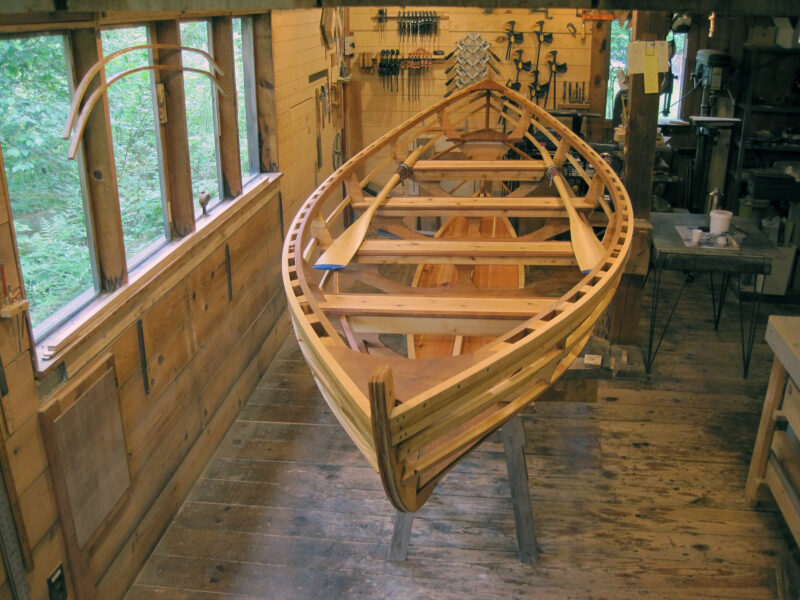 Stephen Schmeck
Stephen SchmeckLaminating the longitudinals in place makes them easier to install and better able to preserve the shape of the hull. The gunwales and inwales have laminates stacked vertically, and those for the chines are grouped side by side.
The frames and stems come out of one 4′ × 8′ sheet of 1⁄2″ marine plywood. The bottom, seats, breasthooks, and other small parts require two 4′ × 8′ sheets of 1⁄4″ plywood, although the plans state that you can substitute solid wood for some of the 1⁄4″ plywood parts. We used western red cedar for the bottom, cherry for the breasthooks, and a combination of cedar and cherry for the seats. The plans indicate that the finished boat should weigh between 120 and 150 lbs; it is likely that the use of solid wood contributed to our boat’s weight being closer to 160 lbs.
The build went smoothly, beginning with positioning the frame patterns on the plywood and avoiding, as much as possible, the eye-shaped patches made in the manufacturing of the fir plywood. I cut the frames out a little oversize with a sabersaw and then shifted to my 1930s-era bandsaw to cut right to the lines. We spent an afternoon filling the voids in the edges with thickened epoxy and sanding the frames.
We set up the frames and stems atop the keel on a 10′-long 2″ × 6″ strongback. The manual emphasizes that the gunwales and inwales should be made up of thin strips that get laminated in place. The laminates, unlike solid longitudinals, will be easier to bend around the frames and, as the manual notes, “will be both stronger and will permanently hold their shape, rather than forever after trying to straighten back out.” Once we had screwed and epoxied the gunwales and chines into notches in the frames, the structure began to look like a boat. The bottom, whether it’s 1⁄4″ plywood or a panel made of three 3⁄4″ cedar boards joined by cleats, is laid in place and traced along the chines to determine its shape. After it has been cut out, the bottom is screwed and glued to the chines at its perimeter. After the framework has been sanded and oiled, it’s time to skin the boat.
When we built the dory, we were able to purchase 13-oz uncoated polyester fabric for the skin from George Dyson, Baidarka & Co.*, which then had plenty of the material in stock. An alternative today, is Spirit Line Kayaks in Anacortes, Washington, which offers ballistic nylon fabric for covering skin-on-frame boats.
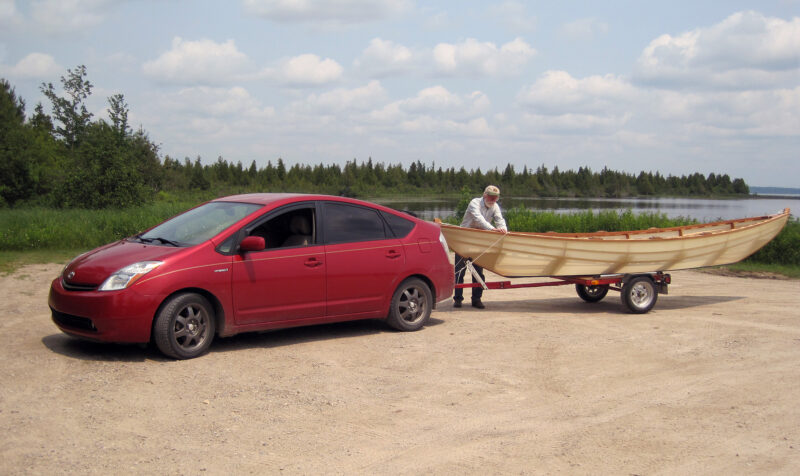 Susan Robishaw
Susan RobishawAt around 150 lbs, the gunning dory could be cartopped if the roof racks are wide and strong enough and have adequate space between them, but a small trailer makes transporting easier. This utility trailer has had a tongue extension added. Note: Local vehicle regulations may limit how far a boat can extend beyond its trailer.
We stretched the fabric lengthwise and attached it, gunwale to gunwale, with stainless-steel staples. At the stems we stitched the fabric into a tight roll with nylon artificial sinew. Running a hot clothes iron over the fabric took out almost all the wrinkles, and I used my pyrographic wood-burning tool as a hot knife to trim the edges of the fabric.
The manual recommends applying a thin coating of PL Premium construction adhesive to the bottom to increase abrasion resistance. This worked out well and by working the goop into the weave of the fabric a small area at a time, the bottom ended up with a smooth, tough surface. I painted the bottom with a few coats of oil-based enamel and then the whole exterior of the hull with four coats of oil-based spar urethane to make it waterproof. [Spirit Line Kayaks offers an exceptionally durable and translucent two-part urethane that is widely used by builders of skin-on-frame boats.—Ed.]
This was my first time building anything from plans, so I was pleased that it all went smoothly. From start to launching took only three months. I had built a lot of things over the years but never a boat. I’d say that anyone with basic woodworking skills and the discipline and patience to read and understand the plans, could build the Gentry gunning dory. Having access to common shop tools and a decent covered space, the size of a single-car garage, helped the project along. I learned a lot, like how to scarf short stock into the long pieces required for the build and, of course, the whole skinning process. I have since used those skills to build four more skin-on-frame boats and they all float!
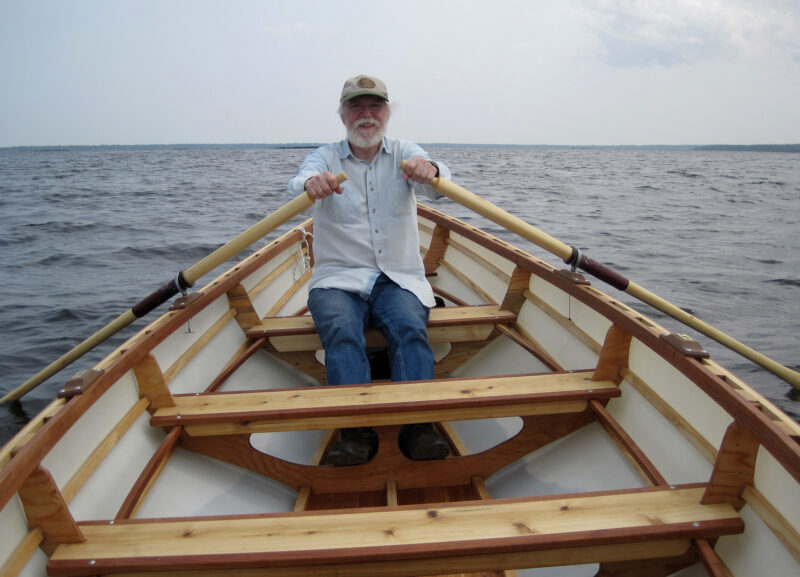 Susan Robishaw
Susan RobishawRowing solo at the forward station keeps the dory in good trim with a passenger in the stern. Note the area of the translucent skin either side of the bottom where the water darkens it.
The finished dory is an open boat with no enclosed storage areas, so we tend to keep things organized and secure by clipping small duffle bags to the frames. Rigid insulation foam, cut to shape from the 4 × 8 sheets available from home improvement stores, is installed under the thwarts and end seats to provide flotation.
Like Gardner’s gunning dory, the Gentry version has three rowing stations. The two in the ends are well-spaced for rowing tandem. The center station is for rowing solo or with passengers in the ends. Sue and I usually take turns rowing at the forward station in half-hour shifts while the other relaxes in the stern. There’s not a transom to lean against, so I like having the back-support of a folding (foam) camp chair when it’s not my turn at the oars.
Although the plans mention that one might be able to cartop this boat, I believe it is more realistic to use a small trailer. I modified an inexpensive kit utility trailer by adding 8′ to the tongue, removing one of the spring leaves from the stack on each side to soften the ride, and carpeting the deck. At most ramps I slide the boat off and on the trailer without even getting the wheel bearings wet, but I did install a winch to help at particularly steep launch ramps. The boat rides well on the trailer and hardly affects the gas mileage of our older Prius. With a little planning it takes only a few minutes at the ramp to launch or load. Because of its flat bottom and light weight, the dory is a cinch to handle on the beach and we have safely launched into moderate surf.
Although the boat is relatively beamy, in the bottom its maximum beam is only about 20″ and when only lightly loaded the secondary stability is slow to kick in. When stepping aboard you need to step firmly into the middle of the floor and get seated quickly. Once you are seated all’s well. Moving about when under way— for example, when changing rowers—does need to be done with good coordination between crew. With four aboard (or the equivalent weight in low, securely placed gear or ballast) the boat is much more stable. Dave recommends 7′ 6″ oars. We have ended up with two pairs that are slightly different: Sue’s are 7′ 9″, while mine are 8′ 4″.
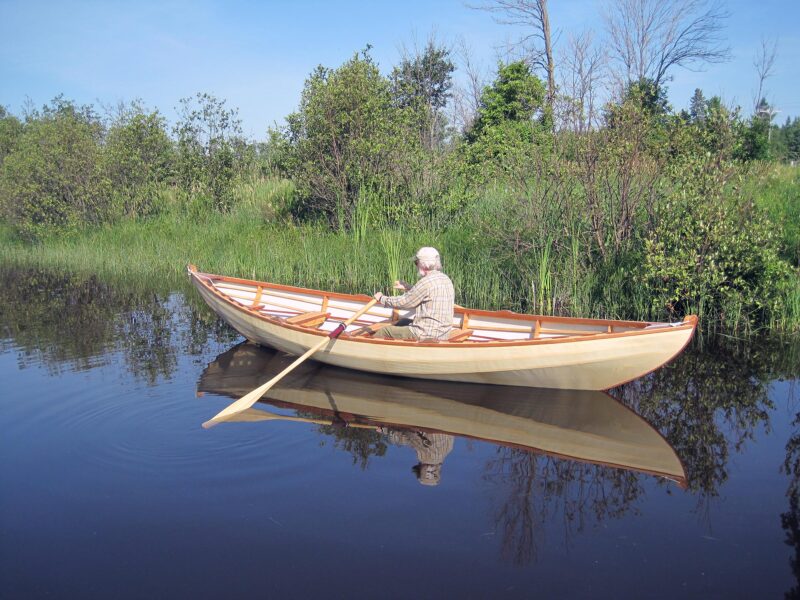 Susan Robishaw
Susan RobishawThe Gentry gunning dory is the same size as the one described in John Gardner’s books but is considerably lighter and will sit higher in the water while carrying a similar load.
I have not verified our rowing speed with a GPS but estimate that at an easy, sustainable pace in flat water the boat cruises at around 3 knots. It is quite dry with little spray coming aboard, takes breaking waves and wakes predictably, and seems to bound over larger waves. At first, this latter action can be unsettling, but you soon realize that the boat is doing just fine.
The three rowing positions allow a solo rower to shift forward or aft to compensate for wind, waves, and load. The frames are well spaced for foot bracing, though the under-seat foam flotation can make things a little tight for those with longer legs and larger feet—I’m 5′ 10″ and my size-10 shoes fit fine. A bit of planning and slight flotation modification could allow more room for longer-legged rowers.
The boat is highly maneuverable and glides well between pulls as long as it is not heading into a strong wind. In calm conditions it tracks well, but in windy conditions, if only lightly loaded, it can be a handful to keep on course. Waves don’t affect the boat as much as a headwind does. We have been caught downwind a couple of times when the wind has shifted through 180 degrees, forcing us to hug the windward shore to get back to our launching site. Adding people, gear, or water bags for ballast settles the hull deeper and makes it less susceptible to wind and waves.
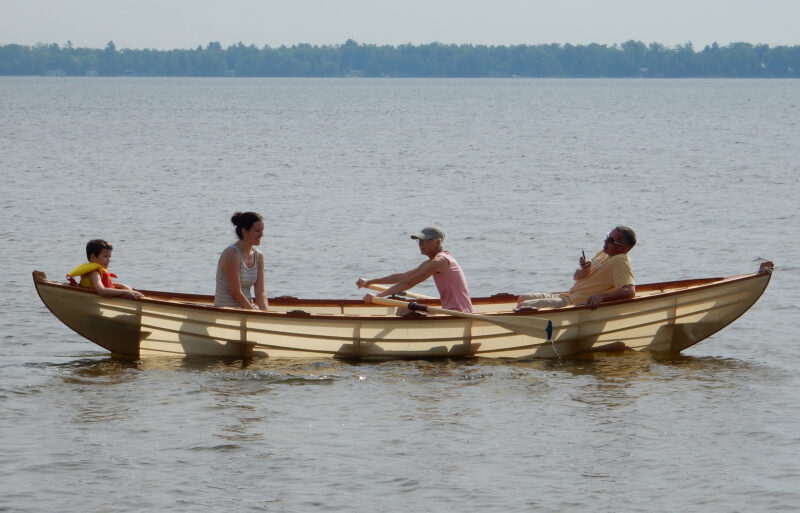 Stephen Schmeck
Stephen SchmeckWith four aboard, the dory still has plenty of freeboard.
The wide expanse of the skin that would be the garboard and the first broadstrake on a traditionally built dory drums a bit in a chop, but I find the sound and being able to see the wave action through the translucent fabric of the hull are among the most enjoyable aspects of being on the water in this boat.
Our original thoughts were to do some cruising and camping, but so far, we have used the boat exclusively for day trips on local lakes, rivers, and in Lake Michigan’s bays. I do think it will work well for beach camping as long as we keep track of the wind direction and have the flexibility to wait out unfavorable conditions. If you’re looking for a boat that really gets attention at the ramps and beaches, is easily handled and relatively quick to build, Dave Gentry’s skin-on-frame Chamberlain Gunning Dory might be for you.![]()
Steve Schmeck and Sue Robishaw are enjoying life on their off-grid homestead in the Upper Peninsula of Michigan. When not building boats, they play old-time music, grow most of their own food, heat their home with wood and solar, and use a water-pumping windmill. They share their thoughts and practical advice with the wider world through their website, ManyTracks. They built the first of the Gentry gunning dories and provided photographs for the manual.
Chamberlain Gunning Dory Particulars
LOA: 18′ 4″
Beam: 4′ 8″
Weight: 120–150 lbs
Maximum recommended capacity is four adults plus gear.
Plans for Dave Gentry’s skin-on-frame Chamberlain Gunning Dory are available from Duckworks.com; digital PDFs $60, printed plans $75.
*George Dyson has limited supplies of fabric remaining and will not be restocking. Email requests to the editor will be forwarded to George.
Is there a boat you’d like to know more about? Have you built one that you think other Small Boats readers would enjoy? Please email us.
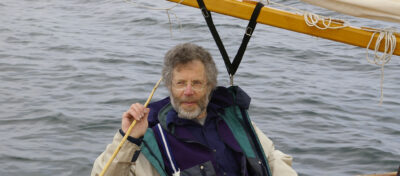
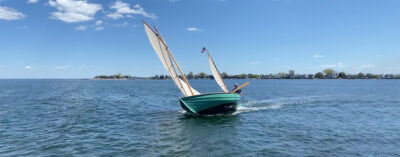
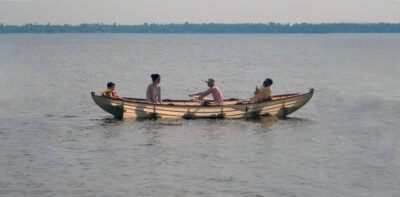

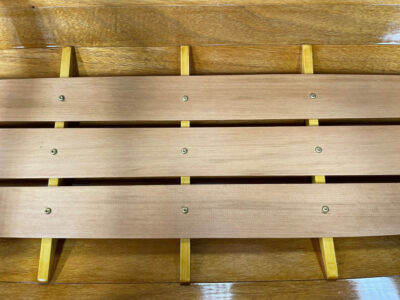

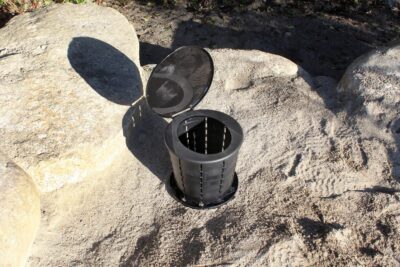
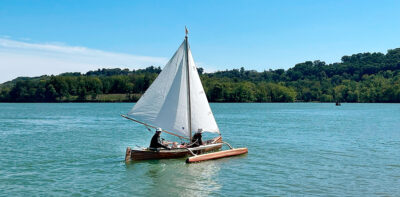

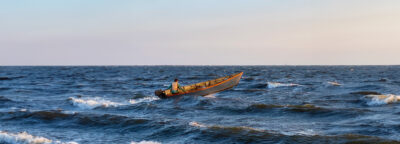
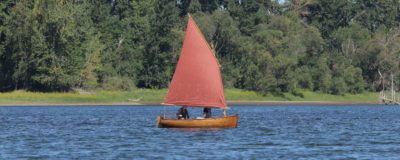
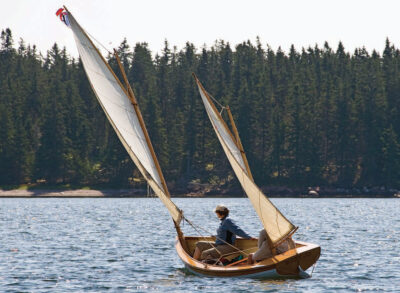
I love these classic lines with ultra low weight steathing.